Learn how to make this soft and chewy gluten free bread recipe! It’s easy to make without too many ingredients and too many complicated steps. If you’ve been missing bread in your gluten free diet then look no further with this recipe!
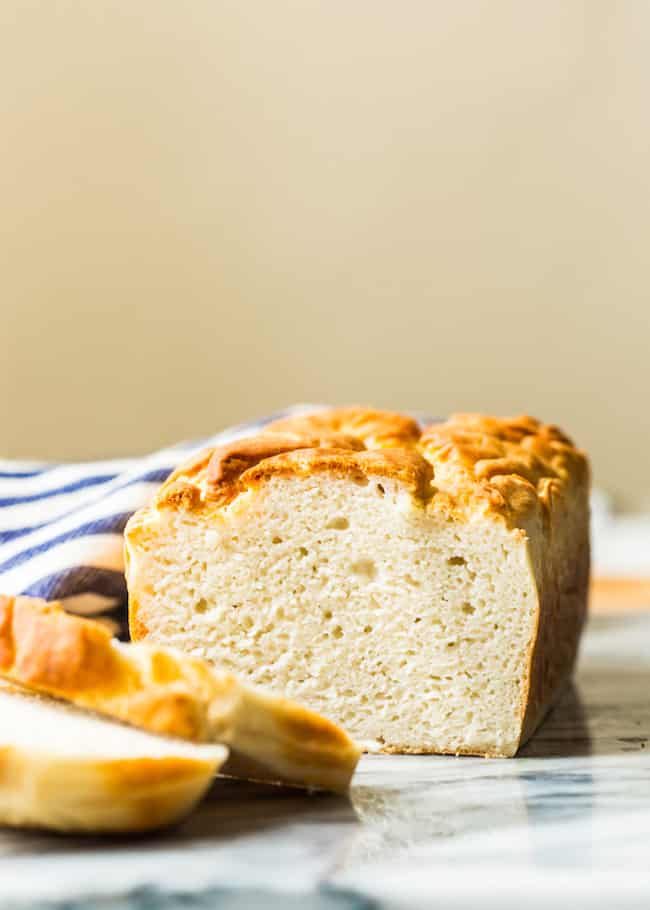
Bread
Who doesn’t love it? Fresh out of the oven, crusty, artisan bread slathered with butter, or drizzled with olive oil? Gimme all the bread.
It’s the perfect accompaniment to pretty much any main dish while also being just as satisfying on its own.
It’s also the destroyer of diets with its carb filled goodness and an actual source of pain for the millions of people who are afflicted with Coeliac Disease or gluten intolerances. Historically, gluten free breads have been…well…sad. Dry, crumbly, tasteless, not to mention expensive. Thankfully, as time goes on and the demand for gluten free products increases we’re getting better at making do sans gluten without compromising taste and texture.
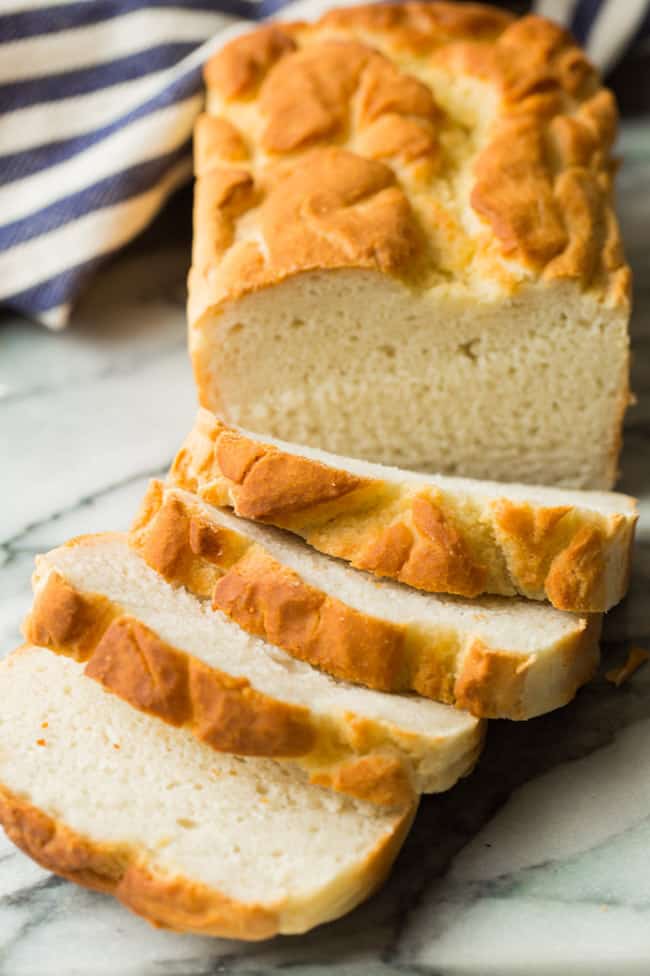
Homemade Gluten Free Bread Recipe
Altogether this bread is made up of about 10, fairly basic ingredients without too much effort.
Unlike a lot of really great gluten free recipes this bread only requires two different types of flours: rice and tapioca. Since I first made this bread years ago rice & tapioca flour have become one of my favourite combos whenever I’m looking for an easy GF flour blend (like in these Yorkshire Pudding).
Yeast Prep Steps
- Whisk together most of your dry ingredients: flours, salt, xanthan gum and baking powder. Set that bowl aside.
- Dissolve the sugar in warm water.
- You want your water to be warm to the touch, but not hot. Too hot and the heat will kill the yeast which will prevent the bread from rising.
- Stir in the yeast and then let the mixture sit aside for about 5-10 minutes as the yeast foams up.
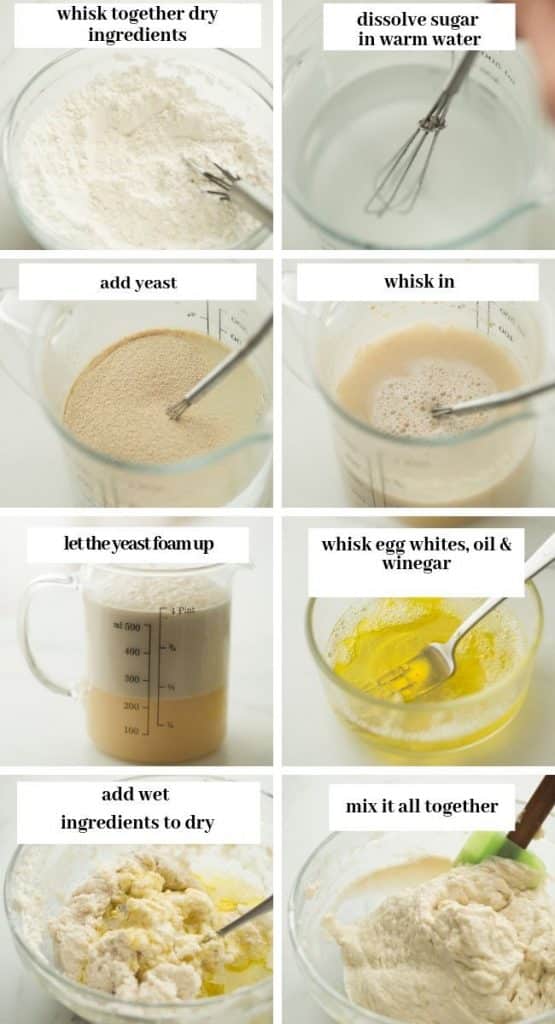
Dough Steps
- Whisk the eggs, oil and vinegar in another small cup or bowl. You don’t need to mix too much, just enough to get the egg whites slightly foamy.
- Add the yeast-mixture and the oil-mixture to the flour mixture and combine.
- The dough is going to look very wet and very unusual. As long as you mix until no lumps of flour remain you’re alright.
- Spoon the batter into a prepared loaf pan, cover and set aside in a warm place. Let rise at least 30 minutes. The bread should have risen by at least 30%.
- Place in the preheated oven and bake for 35-40 minutes. Let cool for at least 15 minutes and then enjoy!
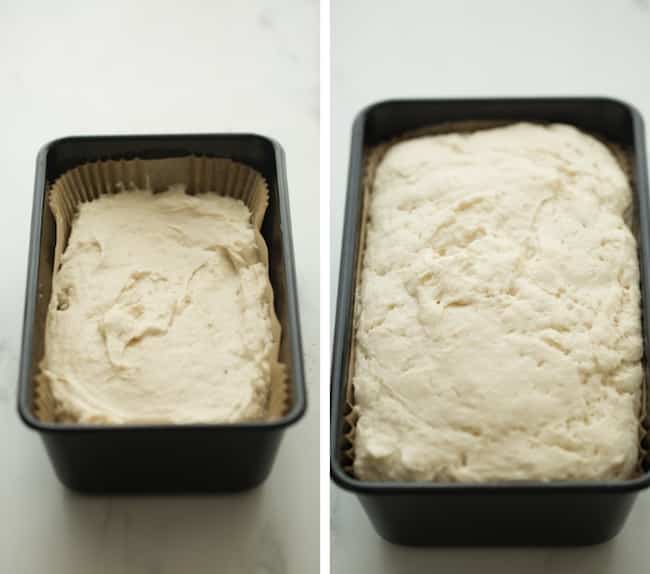
Tips
- Since there is no gluten to over work, don’t be afraid of mixing this bad boy up. If you have a stand mixer, that’s perfect. If you don’t have a stand mixer, give yourself a good arm workout and put some elbow grease into it. I tried this out with an electric handheld mixer, and while it did eventually work, I wouldn’t use it again because my dough kept getting stuck.
- The fully mixed dough will look very wet. The first time I made a gluten free dough, I was concerned I had messed up somewhere along the lines because my dough was sticky, wet, and needed to be spooned into my bread pans.
- I find this to be true with baking in general, but especially when working with yeast please make sure to use room temperature ingredients so that the yeast has the opportunity to rise properly.
Can I Make this Egg Free?
Yes! I have a Gluten Free Vegan French Bread recipe you can make! Instead of egg whites, that recipe uses aquafaba (the goopy liquid found in cans of beans). Weird, but it works!
Can I use different flours?
- You can use brown or white rice or a combination of the two.
- You can use arrowroot starch in place of tapioca flour.
- Beyond those changes I haven’t played around much with other types of flours. I do think you could probably use potato starch as well in place of the tapioca but I can’t say for sure yet. I am currently working on a grain free/paleo bread so stay tuned if you’re interested in something like that. (Update: Everything Bagel Almond Flour Bread)
Do I have to use xanthan gum?
Xanthan gum does a couple of things in this recipe: it helps hold on to moisture (something gluten free goods are often desperate for) and provides added structure which is something that gluten would normally provide. Without xanthan or some kind of binder gluten free goods can be dry & crumbly.
If you can’t buy or use xanthan you can use guar gum instead. Both of these can usually be found in the baking or gluten free section of major grocery stores. If all else fails you can always find these on Amazon.
Why didn’t my yeast mixture foam up?
Your water was too hot or too cold. Too hot will kill the yeast and too cold it won’t fully activate.
Your yeast is already dead. Yeast has a shelf life of about 4 months. It can last longer than that but there’s no guarantee. If it’s been awhile since you last used it you may need to buy more.
Can I use sugar substitutes or leave out the sugar all together?
The sugar helps us to see that the yeast is working as it’s what makes it foam up. It’s not actually 100% necessary for the bread, though a little sugar does help with the flavour. If for whatever reason you can have or don’t want to use sugar just leave it out.
- Sugar subs like erythritol & swerve won’t work for the yeast.
- Honey, maple and coconut sugar all work.
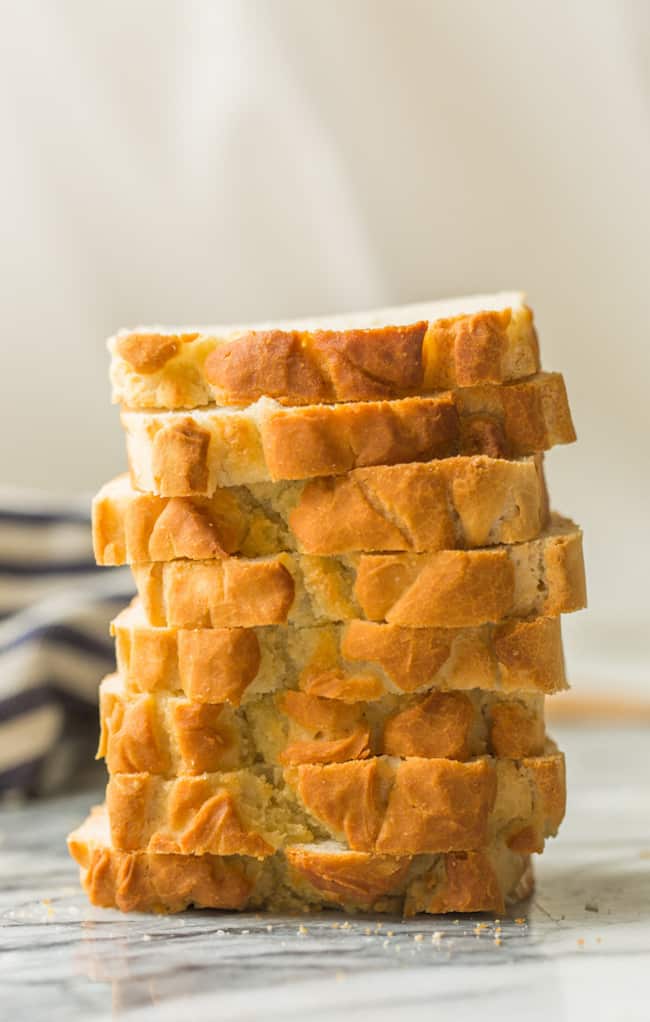
If you have any more questions please let me know in the comments below!

Easy Gluten Free French Bread
Learn how to make this soft and chewy gluten free bread! It's easy to make without too many ingredients and too many complicated steps. If you've been missing bread in your gluten free diet then look no further with this recipe!
Ingredients
- 2 cups rice flour (white or brown) (280g)
- 1 cup tapioca flour (100g)
- 2 teaspoons xanthan gum*
- 1 tablespoon gluten free baking powder
- 1 teaspoon salt
- 1 1/2 cups lukewarm water, (360ml) between 105-110 degrees F, 40-43C
- 1 tablespoons gluten free quick rise yeasts
- 2 tablespoons sugar
- 2 tablespoons olive oil
- 3 egg whites, lightly beaten
- 1 teaspoon apple cider vinegar (you can substitute for another vinegar if you don't have ACV
Instructions
- Whisk together your flours, xanthan gum, salt and baking powder.
- In another bowl or jug mix together hot water and sugar. Stir until your sugar dissolves then add the yeast. Let the yeast foam up for a few minutes.
- While the yeast is foaming up, beat together your three egg whites slightly. Mix in the oil and vinegar.
- Pour the yeast mixture to the flour mixture along with the eggs and mix it all together. Make sure to mix everything until no lumps remain.
- Grease or line 2 (8x4 inch) loaf tin or one french bread pan and spoon your batter into each tin. Cover and stash in a warm place for at least 30 minutes. I like to stow my dough in the microwave or a warmed but off oven for rising process because it keeps my dough free from drafts and disturbances.
- After your dough has risen by about 30% (about 30 minutes) preheat your oven to 400°F/ 200°C. Place in the middle and bake for 35-40 minutes, turning the dough about half way through for an even bake.
- Remove from the pan and cool on a wire rack for at least 15 minutes until you're ready to slice and serve.
Notes
Recipe lightly adapted from Food.com
Can I make it egg free?
- Yes! You can find the egg free/vegan version of this bread by clicking through to the link here.
Can I use different flours?
- You can use brown or white rice or a combination of the two.
- You can use arrowroot starch in place of tapioca flour.
- Beyond those changes I haven't played around much with other types of flours. I do think you could probably use potato starch as well in place of the tapioca but I can't say for sure.
Can I use sugar substitutes or leave out the sugar all together?
- The sugar helps us to see that the yeast is working as it's what makes it foam up. It's not actually 100% necessary for the bread, though a little sugar does help with the flavour.
- If for whatever reason you can have or don't want to use sugar just leave it out. Sugar subs like erythritol & swerve won't work for the yeast.
- Honey, maple and coconut sugar all work.
Do I have to use xanthan gum?
- Xanthan gum does a couple of things in this recipe: it helps hold on to moisture (something gluten free goods are often desperate for) and provides added structure which is something that gluten would normally provide. Without xanthan or some kind of binder gluten free goods can be dry & crumbly.
- If you can't buy or use xanthan you can use guar gum instead. Both of these can usually be found in the baking or gluten free section of major grocery stores. If all else fails you can always find these on Amazon.
Nutrition Information
Serving Size:
1 Calories: 115Total Fat: 2gSaturated Fat: 0gTrans Fat: 0gUnsaturated Fat: 2gCholesterol: 0mgSodium: 174mgCarbohydrates: 22gFiber: 1gSugar: 2gProtein: 2gMore gluten free bread recipes you might enjoy:
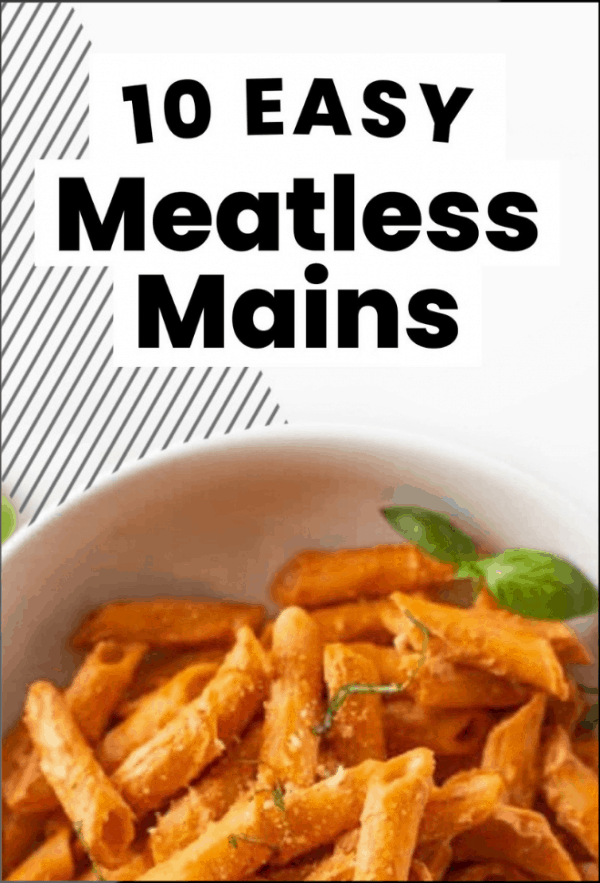

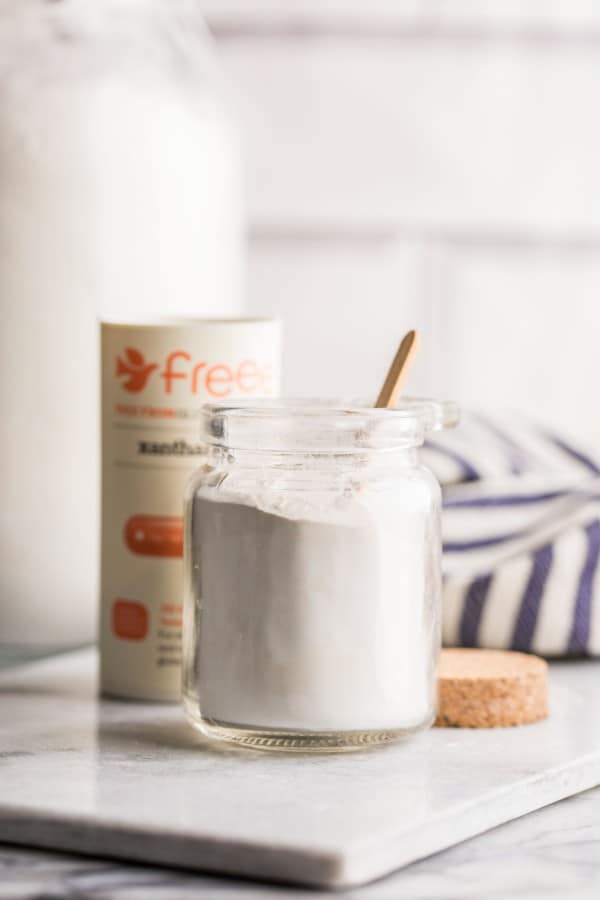
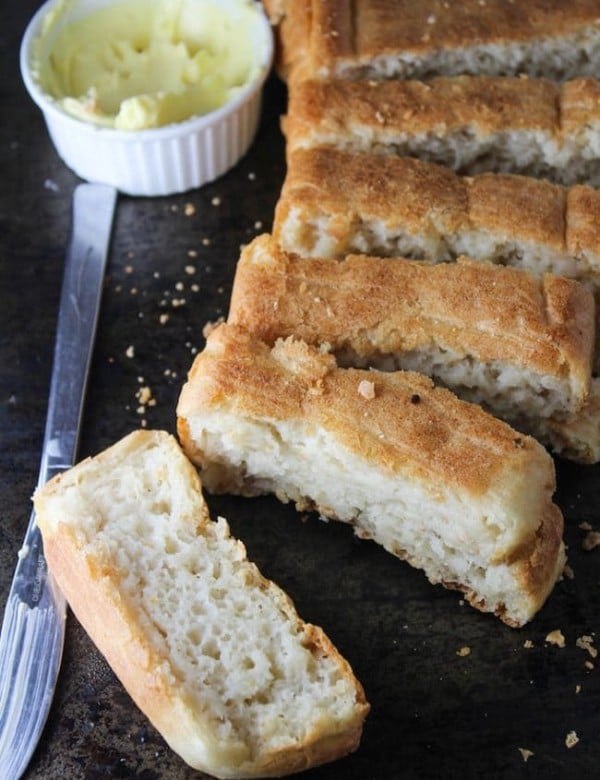
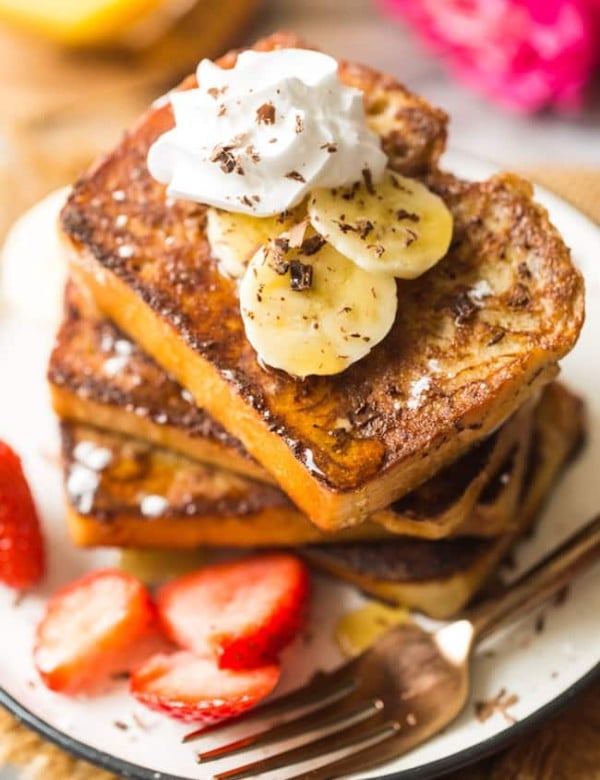
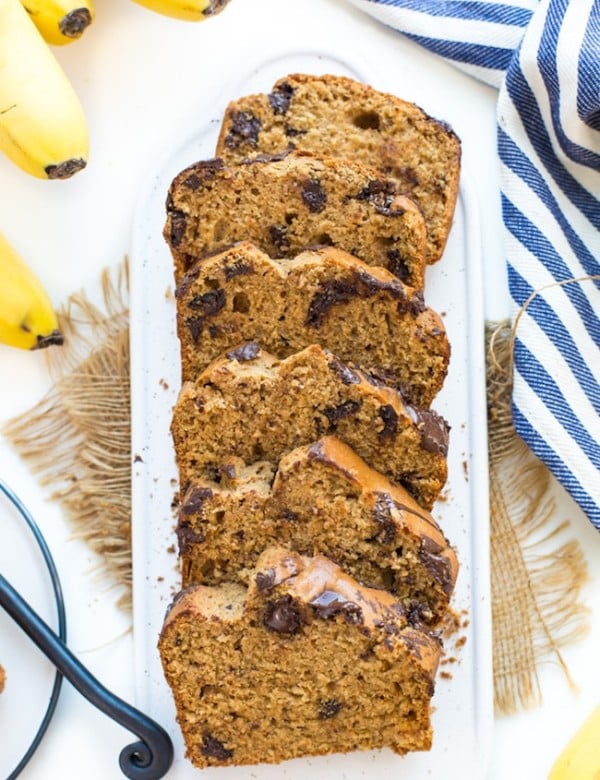
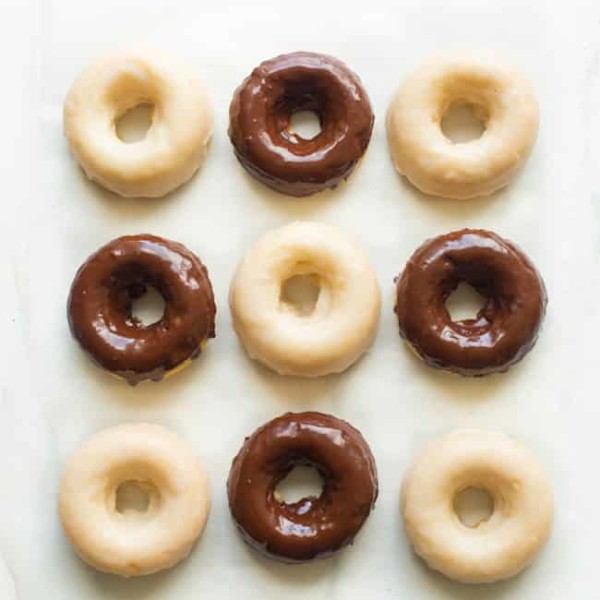
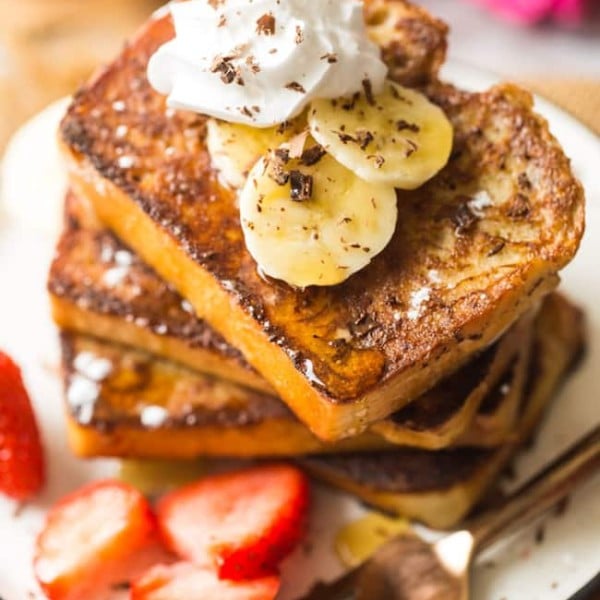
Nicole says
Hello this bread look delicious, i would love to do it.
But i have a problem in my country in Portugal i dont think we have Xantham Gum so what can i use to replace or do i really have to use it ?’
I have IBS and i cant eat eggs what is the best to substitute eggs ??
Thank yoou
Sarah says
Hi Nicole! As far as the eggs go I’ve made an egg free version of this recipe using aquafaba (chickpea water) that you can find here: https://www.asaucykitchen.com/gluten-free-vegan-french-bread/
As for the xathan gum, I’ve never tried this without using xanthan, guar gum or psyllium husk (which is also probably hard to source). Have you tried looking it up on Amazon? I sometimes have to buy things there that I can’t easily find in the UK.
Suzanne says
My first time making this bread today. I wouldn’t call it an epic fail, but I would do things differently next time.the recipe is great. This was just a bad choice of pans. I used a double baguette pan. Seemed like a good idea at the time. The bread didn’t rise much before going into the oven, so I thought it was safe. Wrong. The bread doubled in size in the oven. The outside, especially the top, got too well done, and the inside was not done. Not wanting it to go to waste, I cut it into pieces 2-3 inches long and put them on parchment on a cookie sheet, back into the oven at 325. For 12-13 minutes longer. Better, but still not what I wanted.
The dough was a great consistency. I believe next time I will try just shaping I into a loaf or two on parchment on cookie sheets. Hoping that wil work.
Sarah says
Oh no! Sorry things got messy with the pans – I’ve been there! I hope next time it works out better for you!
Valeria says
Hi
Recipe is very good, a couple of times I’ve made,very good taste.
But I have one question,how can I replace xanthan gum with psyllium husk?
In which amount to replace him,
whether they should mingle with hot water the psyllium husk?
I’m sorry a lot of questions :))
But I really like the bread
Sarah says
Hi Valerie! I’m glad you like the bread!
To be honest, there are times when I just toss the psyllium husk into the dry ingredients just as I would with xanthan. It’s a 1:1 substitute so it’s pretty easy. The best way to incorporate psyllium according to what I’ve read other people do is to mix it with water until it gels up and then add it into the bread dough at the end. So in this case you would mix 1 teaspoon psyllium with 1 tablespoons water, whisk it together and place in the fridge for about 5 minutes. It will become thick and gel like and you can just mix that into the rest of the dough. I don’t think there should be an issue mixing the psyllium with the warm yeast water, so no worries about that. Hope this helps!
Cindy says
Can you make this with out the psyllium I do not have that or the substitute
Sarah says
Hi Cindy! I’ve never tried this recipe without using psyllium husk or xanthan gum so I’m not sure how it would turn out. That being said I have made many gf recipes leaving out one of the two when I don’t have it it and the recipes usually work out mostly. They’re usually much more crumbly (pysllium & xanthan work as binders here) and the dough is usually much more fluid which can be trickier to work with. Again though, I can’t really say how well it would work without. If you do try it let me know how it goes! I’d love to know 🙂
Michelle says
I’m wondering how you store this and how long it’s good for?
Sarah says
Hi Michelle! I don’t think we’ve ever had a loaf last more than two days. It usually gets devoured almost as soon as I make it. To be honest I don’t think it would be great past that point anyways because it starts to go a bit too dry. I keep ours wrapped foil or cling wrap to keep it from drying out too much
Jon says
I just tried this without eggs for my wife who is gluten intolerant and allergic to eggs. I replaced the eggs and xanthan gum with psyllium husk powder (4 tablespoons total), and put it in while the oven was warming up to get a thicker crust. I ended up adding a bit more water because the dough was so thick. It held together just like wheat dough and I could work it with my hands easily. I made baguettes and they came out great – the crust was perfect, but the centre was a bit doughy. Next time I’ll use less psyllium so I don’t have to add as much water.
Sarah says
Ooh, I’ve never tried replacing eggs with xanthan and psyllium alone. I’m going to try that out myself. The problem I usually run into with gluten free bread is that you can’t handle it too much. Thanks for sharing! I’m glad you liked it!
Dahn says
I can never wait for the bread to cool down after I take it out of the oven.. that’s when it is the best. this looks amazing.
Sarah says
Same! When the butter is all melty….ooh it’s the best!
Lisa says
This looks delicious!! I’d like to make this for a friend but they also happen to have an egg allergy – any idea of what to substitute for the egg whites?
Sarah says
Hi Lisa! I can’t say for sure because I’ve never tried it for myself, but I was listening to a podcast from America’s Test Kitchen just this week where a person called in asking about the best egg substitutes in baking because she had an egg allergy. They recommended the brand Egg Beaters as being the best one – if you do try that do it as if you are replacing 1 whole egg rather than 2 egg whites. Let me know how it goes or if you find another suitable substitute!
Peggy says
I have to point out here that Egg Beaters IS still eggs, just the whites without the yolks, so if you are actually allergic to egg whites or the whole egg, this would not be an appropriate substitution. I know flax or chia “egg” can be substituted in many recipes, but I wonder if it would significantly change the end result in this one.
Sarah says
Oooh, sorry about that! Since they were talking about egg substitutes I assumed egg beaters wouldn’t actually be eggs – my bad! I just found this article from the Kitchn about vegan egg replacers and Ener-G sounds like it could be the closest thing.Thanks for pointing that out to me!
Diana G says
you can try a flax egg. 1Tbsp ground flax with 3Tbsp warm water. Mix it up, let it gel a bit and mix in.
Jessica says
I have no idea if it could successfully be substituted in this recipe but I have used the water from a can of chickpeas (called aquafaba) to make meringue cookies, and coconut macaroon. So, she may want to experiment with that. There are also egg replacer powders that you can find at health food store, usually by the flours.
Sarah says
Oooh I’d be really interested in trying that out myself. I just heard about aqua faba last week and how you can use it as an egg free meringue so I wonder how well it would work as egg whites in other situations. Thanks, Jessica!
Sarah says
Hi Jessica! I tried your suggestion with the aquafaba and it worked! I posted a new recipe with the adjustment here if you’re wondering https://www.asaucykitchen.com/gluten-free-vegan-french-bread/
Thank you so much!
Deb says
Can you share those recipes using aqufaba, please?
Sarah says
Hi Lisa! Sorry this comes a bit late, but I’ve just posted a new recipe for this bread using aquafaba (the water from chickpea cans) based on another commenter’s suggestion and it works wonderfully if you’re still interested in trying an egg free version.
https://www.asaucykitchen.com/gluten-free-vegan-french-bread/
Have a good day!
Dawn says
That looks delicious ? I was just wondering what kind of loaf pan you used? It doesn’t look like it came out of a loaf pan. It’s long and browned on all sides which I love. It almost looks Loire it was baked in a French loaf pan.
Sarah says
Thanks Dawn! I wasn’t sure the exact size so I just measured the pan I used and it’s an 9in x 5in pan which gives me a wide loaf. I have since done this in a French loaf tin and I really like how it works with that as well – it comes out a lot longer in length and smaller around the middle which makes it great for sharing since it goes further than way. Let me know if you have anymore questions!
Megan says
Oh my goodness gracious this bread is amazing. Not even 5 minutes out of the oven and I know this will be my go-to. I put some of the dough in an 8×8 pan with some garlic powder and Italian seasonings and it made delicious foccacia bread.
Thoughts on making this into a thicker pizza crust? The texture is perfect but the dough may be too sticky. Hmm….
Sarah says
I’m so glad you like it! I’m going to take a leaf out of your book and make in into foccacia too – that’s brilliant. I’ve actually tried using this as a pizza dough – I baked it in a round cake tin so that it would hold its shape. I really liked it, but I wished that I would have used less dough in the crust because the pizza topping to bread ratio was a bit off. That being said, we still devoured it! Another thing you could do is to bake it as a baguette and then cut it in half to make pizza boats out of it. That always goes over well with company because it’s so easy to cut and serve
Sea says
This recipe is bette hagman’s from more from the gluten free gourmet cookbook. Ive been making it for years and it is good. Better in a french bread pan.
Sarah says
I’ll have to check out her book if all the recipes are as reliable as this one! I originally found this recipe from Food.com which I link to at the bottom of the post. Whoever posted that one must have been inspired by Bette Hagman’s recipe. I just made a few slight changes for a dairy/ refined sugar free and I love it. I agree about the French bread pan too- I bought one a few months ago and I love the way the bread comes out with it